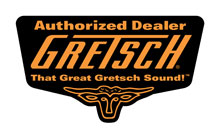Gretsch Guitars
Check Out Gretsch Guitars Now!
Gretsch History:
For more than 100 years Gretsch has developed what came to be known as “That Great Gretsch Sound,” but it all began with a young German immigrant in Brooklyn. At 27, Friedrich Gretsch founded a small musical instrument shop 1883 to make banjos, drums and tambourines. Only 12 years later Friedrich died, leaving the fledgling company in the hands of his teenage son Fred. While it may be an unlikely start for a century-long (and growing) musical legacy, young Fred wasn’t the typical teen. By 1916 he had built the company into one of America’s leading importers and manufacturers of musical instruments, and the operations moved into a 10-story building at 60 Broadway in Brooklyn.
Fred knew listening to what the public wanted was the key to growth, and the public wanted guitars. So, Gretsch began making guitars. Initially, Gretsch offered acoustic archtops aimed at jazz musicians, and a handful of flat-tops for country-western performers. Meanwhile, 1935 marked an important year for Gretsch — Duke Kramer joined the team. Kramer went on to become a mainstay of the Gretsch company, and remains a valued counsel to this day.
“That distinctive sound was our product, the sound that energized the market for decades,” Kramer says. Fred Gretsch, Sr. retired from the company in 1942, leaving the day-to-day operations to his sons Fred, Jr. and William. Fred Gretsch, Jr. managed the company briefly, then left the company to serve with distinction as a commander in the Navy, and Bill Gretsch became president. Kramer recalls, “Bill was a man with a subtle talent for inspiring people to do their best and a genius for constructive counsel. His sense of humor was irresistible. When he passed away in 1948, a legion of individuals felt they lost their best friend.”
Command was again passed to Fred Gretsch, Jr. and the Navy veteran led the company into a new age of prosperity in the “atomic age” ’50s. Gretsch, being the first to use custom color finishes, and offering a wide variety of space age gizmos and gimmickry, was uniquely positioned to succeed in the era. Through the 50s, they even outsold Leo Fender’s wonderful new creations. High-profile artists and endorsers like Chet Atkins, Eddie Cochran and Duane Eddy didn’t hurt, either.
The ’60s brought a further boost to Gretsch when George Harrison played a succession of Gretsch models. In the late ’60s, Fred Gretsch retired and sold the company to Baldwin Manufacturing. Baldwin had difficulty understanding Gretsch’s position in the market and failed to make a transition through the psychedelic ’60s and hard-rock ’70s. Kids inspired by Jimi Hendrix, Jeff Beck and Eric Clapton turned to Fender. To make matters worse, Baldwin moved production to Arkansas, and Gretsch suffered through two disastrous fires. The Baldwin marriage was always an unhappy one. With sales down and the head office increasingly disinterested, Gretsch limped through the 70s and finally shut down production in the early 80s.
But ever since the company had left the family, Fred Gretsch III had vowed it would return. In 1985 his dream came true, and through the 90s he brought Gretsch back into the limelight with a series of successful re-issues and new models. In late 2002 a deal was struck for Fender Musical Instruments Corp. to handle Gretsch manufacturing and distribution, bringing that “Great Gretsch Sound” to be heard worldwide once again.

